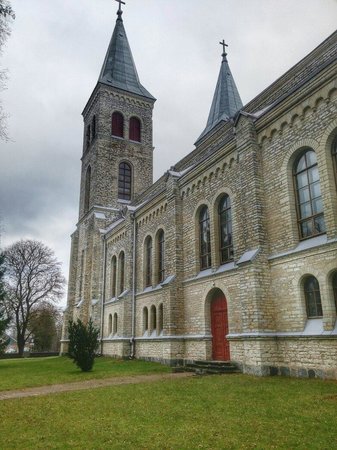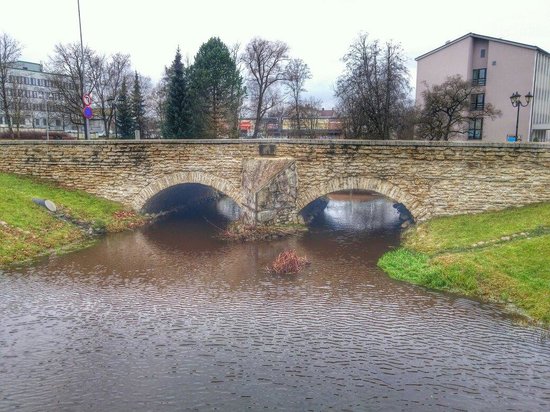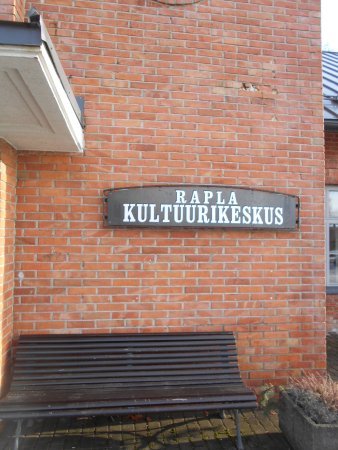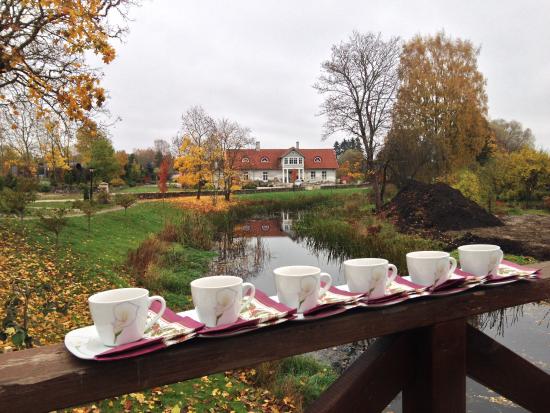10 Things to Do in Rapla That You Shouldn't Miss
Rapla is a town in central Estonia, the administrative centre of Rapla County and Rapla Parish. The oldest records date back to 1241 in the Danish Census Book, when it was said that it was a small village with 8 acres of cultivated fields. By the end of the 13th century the village centre was firmly established. At around the same time a Cistercian monastery was built.
Restaurants in Rapla
1. Rapla Maarja-Magdaleena Church
Overall Ratings
4 based on 6 reviews
This Rapla church is the only rural church with two towers in Estonia. The New Roman style building that was consecrated in 1901 was designed by Baltic German architect Rudolf von Engelhardt, and is one of the purest examples of this style in Estonia. Interesting facts: The pulpit and altar were produced in the workshops of Christian Ackermann and Quirinnius Rabe. The Rapla Church Music Festival got its start in the Rapla church. In the church you can listen to the organ produced by Estonia’s renowned organ master craftsmen, the brothers Kriisa. The limestone building can accommodate 3,000 people. In the churchyard you can see round crosses dating back to the 17th century and the monument to the War of Independence designed by Jaan Koort.
2. Rapla Stone Bridge
Overall Ratings
4 based on 6 reviews
This bridge, which crosses the Vigala River, was built in place of the former wooden bridge in the late 19th century. A reinforced concrete structure was superimposed on the old bridge in 2009, and pedestrian Bridges were added on either side.Did you know…?*The renovated bridge is the only one of its kind in the country*The stone bridge is on the coat of arms of Rapla municipality*A café operates under the bridge on Rapla Day where the dress code is galoshes*River rallies have been held on the river under the bridge, and Performances have been given on top of it*Mermaids have even been spotted in the river!*Bring a Sandwich, come and park yourself by the river and enjoy some time to yourself! You might not spy any mermaids, but you’re sure to see some ducks!
3. Rutmani gallery
Overall Ratings
4.5 based on 3 reviews
The Rutmani gallery forms part of Rapla’s cultural centre. Did you know…?*The gallery was named after the chairman of the education society that existed in Rapla at one time*Various Exhibitions are held here throughout the year*The gallery’s café is a great place to enjoy some fine art and fine coffee*The café’s Terrace often hosts unique musical events
Reviewed By gaida820 - Rapla County, Estonia
This place is quite popular among locals. It is enjoyable to have your meal surrounded by an interesting exhibition. The menu is simple but always interesting. The service is friendly and fast. A good place for meetings, there is one more room to have a meeting and talks.
Special thanks for Pavlova cakes.
4. Hageri-Sutlema rannamoodustised
Overall Ratings
5 based on 1 reviews
5. Jarvakandi Glass Studio
Overall Ratings
5 based on 1 reviews
At the glass studio attached to the Jarvakandi glass museum you will see examples of artificial glass blown using handicraft methods.Did it you know…?*Here you can learn the basics of glass blowing *You can blow glass yourself in the studio or watch the work of glass masters in the public workshop*You can enjoy the wonders of glass blowing and even record special occasions forever in glass
Reviewed By Derettens - Tartu, Estonia
WHEELCHAIR ACCESS - YES
Entry fee €0
Järvakandi is 87.5km due south of Tallinn (2 hours by car), 58km north-east of Pärnu, Estonia's summer capital, and by the glass blower's admission 'in the middle of nowhere'.
The local sand is particularly suitable for making glass and a glass factory, in one form or another, has existed in Järvakandi for more than 100 years and has been and is the main employer in the town and pillar of the economy. There is an international demand for Jarvakandi glass. The town, as a result, has a more prosperous appearance than many other of the county's small towns.
The Glass Studio is one of 3 wooden buildings that form the Glass Museum and Studio complex.
The Glass Studio is open from March to October.
The spectator's area is too small to accommodate groups of more than 6-10 people.
Eero Vaikre - the glass blower - produces glass predominantly for the tourists visiting Tallinn via cruise-ships (passengers do not have to worry about luggage weight restrictions). Prices of Eero Vaikre's glass ornaments in the Glass Studio are much lower than in Tallinn's shops.
Visitors can by prior arrangement have lessons in hands-on glass blowing.
6. Raimond Valgre Museum
Overall Ratings
5 based on 1 reviews
Composer Raimond Valgre (1913-1949) lives in the hearts of every Estonian. Everyone has a slightly different take on the man, but almost all see him as a dreamer, a romantic, talented through and through and completely dedicated to music - of which he is a creator of magical melodies. Musicals, plays and films have been made about him; books have been written about him; monuments have been dedicated to him; and his songs are always being sung. Valgre's contribution to Estonian music and his connections to Rapla, where he spent his childhood years, gave rise to the idea of the Raimond Valgre Museum. Here you can find out all about his life and work, while his famous songs play in the background.
Reviewed By gaida820 - Rapla County, Estonia
Food is not far (next door),it was comfortable to order some delicious meals, wifi and walls full of history. Raimond Valgre was a composer, his melodies are still heart warming and adored by people. To have a seminar there was an excellent idea. Positive aura and environment enhanced the great result of our seminar.
7. Rapla River Promenade
Overall Ratings
4 based on 3 reviews
This Promenade, which winds its way along the banks of the Keila River, is a favourite spot among walkers. On one side it is bordered by the Vigala River, and on the other by the Maarja-Magdaleena church park.Did you know…?*You can picnic on the Promenade, and even share some of your lunch with the resident ducks*The church park is home to Rapla’s oldest building – the parsonage, dating from the 18th century*The parsonage currently houses the Rapla Art Society*While you are here, be sure to visit Rapla church with its unique twin towers*In the church garden you will see a freedom monument designed by Jaan Koort
Reviewed By Cpucc001 - Rapla County, Estonia
The Rapla River is simply the cutest little river I've found wandering through a small quiet town. This Promenade extends back beside the church to a platform over looking the river. It goes much further the other direction back behind the hospital, beside some small Rapids and twists and turns. It's an adorable place for picnics, strolls, Reading a book or meeting a friend
8. Pakamagi Hill
Overall Ratings
3 based on 1 reviews
Pakamagi hill is a flat, forested limestone upland.According to the chronicles of Henry the Latvian, it was a meeting place of the tribal leaders of ancient Estonia. Did you know…? *It is said that the fire which was started as a sign of the St. George’s Night uprising was lit in the village of Raikkula on Pakamagi hill*The western slope of Pakamagi has a Terrace which is 9 metres high where you will find truly ancient rocks*Midsummer bonfires would be lit here in days of old; now the Pakamagi Amphitheatre hosts summer Concerts and performances*This is a perfect place for picnics
Reviewed By W0nderer007 - Kaunas, Lithuania
Definitely not worth special drive there, but once in the neighbourhood, a small stop is OK. Suggest to visit when You can pick berries or mushrooms or want to hike in the forest. Careful climbing on top.
9. Sculpture of Mart Tiru
The portrait sculpture of Brigadier-General Mart Tiru (1947–2005) is located in the heart of Rapla. Former Estonian President Lennart Meri appointed Colonel Tiru the Deputy Commander of the Defence Forces in 2000, and promoted him to Brigadier-General later the same year – making him the first man to achieve such a rank in the country. Tiru played an importance role in Estonia’s accession to NATO.Did you know…?*Tiru’s final place of service was the United States, where he acted as a military representative of Estonia*The sculpture of Tiru was unveiled on Victory Day 2008 by current President Toomas Hendrik Ilves
10. Kuimetsa Karst Area
Kuimetsa is home to one of the most extensive and unique karst areas in Estonia. Visitors to it will see collapsed Valleys, funnels, hollows, channels and caves. Five of the caves in the area are big enough to walk into. One of the biggest is 12 metres long and 8 metres wide and forms the opening of a collapsed funnel. During times of high water you can watch the flows passing through the hollows and channels and hear the rush of the water underground; at drier times, there is hardly any water to be seen at all.. Did you know…?*Here you will find Estonia’s biggest karst caves*The chronicles of Henry the Latvian claim that the ancient Estonians sheltered in these caves from aggressors







